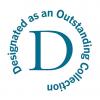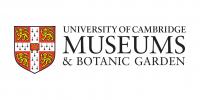Submitted by Tricia Harnett on Mon, 14/03/2022 - 16:09
On 15th March 2022 we are opening a new exhibition, Butterflies Through Time: Using wildlife of the past to guide conservation of the future. The exhibition is a culmination of over two years of work, using UK butterfly specimens from our collection to showcase the natural world and environmental change.
Butterflies Through Time tells the story of 13 local butterfly species over the last 200 years, and the research and conservation currently being undertaken to protect them. The exhibition is based around the work of Leonard Jenyns, a naturalist and friend of Charles Darwin, who lived in Cambridgeshire during the 19th century. Jenyns spent much of his time recording local wildlife in detailed notebooks that are now held at the Museum. The exhibition showcases historical butterfly specimens, offering visitors a chance to see rare butterflies that are usually held behind the scenes in the Museum storerooms, alongside accounts of how these species are faring in modern Cambridgeshire.
The Butterflies Through Time Project is providing information from our specimens and Jenyns’ notebooks to help guide habitat restoration work on nature reserves, in collaboration with local conservation organisations such as the Wildlife Trust for Bedfordshire, Cambridgeshire and Northamptonshire (WTBCN).
A goal of the Butterflies Through Time Project is to engage local school children with butterflies and their conservation. As such, the exhibition also includes art work made by children from local schools. One of the butterflies featured in the exhibition is the swallowtail butterfly. Leonard Jenyns’ notebooks highlight that this species was once common in Cambridgeshire: ‘Found in the greatest plenty, throughout the Fens between Ely & Cambridge’ Sadly, the swallowtail became locally extinct in Cambridgeshire the 1950s due to drainage of its fenland habitat for farmland. The butterfly’s disappearance mirrors changes to many wetland species that were previously found in Cambridgeshire. Jenyns’ notebooks now provide a vital insight into what species were found in Cambridgeshire 200 years ago, and allow us to compare this with wildlife today.
Dr Gwen Hitchcock, a conservationist from the Wildlife Trust for Bedfordshire, Cambridgeshire and Northamptonshire, carries out modern butterfly research and conservation. Of the exhibition, Dr Hitchcock said “It’s really exciting with this exhibition to see how past records can help with the current, and future, conservation of these beautiful and important species. It highlights the importance of biological recording and how, by working together, we can ensure a future for our wildlife.”
Dr Ed Turner, Curator of Insects at the Museum of Zoology commented “Butterflies are among the most beautiful and popular groups of animals. This exhibition highlights the wonderful variety of species found locally, but also their fragility and need for conservation”. The exhibition features 13 species, but this is only a fraction of UK butterflies.
Butterflies Through Time runs from 15th March to 18th September 2022. Admission to the exhibition and Museum is free.
The Butterflies Through Time Project is supported by the Esmée Fairbairn Collections Fund. This Fund is awarded by the Museums Association on behalf of the Esmée Fairbairn Foundation, supporting projects that increase access to museum collections and use them to achieve social impact.
The Wildlife Trust for Bedfordshire, Cambridgeshire and Northamptonshire are partners on this project. Their mission is to create a wilder future by protecting and restoring wildlife and wild places across Bedfordshire, Cambridgeshire and Northamptonshire, for the benefit of both wildlife and people. The University of Cambridge Museums is a consortium of the eight University Museums and the Botanic Garden, supported by Arts Council England. The consortium includes: Fitzwilliam Museum, Kettle's Yard, Museum of Archaeology and Anthropology, Museum of Zoology, Museum of Classical Archaeology, Whipple Museum of the History of Science, The Sedgwick Museum of Earth Sciences and The Polar Museum. The University's collections are a world-class resource for researchers, students and members of the public representing the country’s highest concentration of internationally important collections, all within walking distance of Cambridge City Centre.





